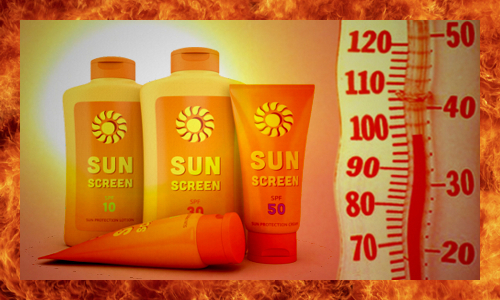Running with sun protection

Finally the harsh winter is gone and the spring weather has improved. Gone are the layers of clothing and most runners have discarded gloves, pants, long sleeve shirts, and head coverings. They have been replaced with shorts, shorter socks, tank tops, sleeveless tops, and occasionally bare chests.
A minimal running-apparel approach to running gear may feel more comfortable but the increased exposure to the sunlight increases the possibility of developing cancer. Since cumulative exposure to the sun is a continuing challenge, it must be successfully mastered. The best ways are a dual approach, using sunscreens and sun protectors. Individually, each method has advantages and disadvantages. Combine the two and the problems seem to disappear.
Why is protection needed?
Excessive sunlight can damage the skin and increase the risk of skin cancer. Runners are outdoors more than many athletes and perspire profusely, which diminishes the effectiveness of many protective agents used against the intense and chronic exposure to sunlight radiation.
Sunburn radiation is caused primarily by Ultraviolet B (UVB) exposure and impacts mostly on the skin surface because of its shorter rays. Ultraviolet A (UVA) increases wrinkling, sagging, skin thickening and aging of the skin because they penetrate to underlying tissues. UVA rays have a longer wavelength than UVB. They penetrate deeper into the skin and affect its elasticity. Both of these rays can also responsible for skin redness and sunburn caused by numerous medications.
Sunscreens should always be used on bald areas of the head, ears, face, back of the neck, arms, and legs. Yes, that also means any other exposed body part.
A web site with source information from Schering-Plough HealthCare Products, the makers of Coppertone and the Environmental Protection Agency (EPA) shows how to protect yourself from the radiation. It also shows the UV Index for your postal zip code and the weather at solar noon each day. This important information is available at: www.coppertone.com/coppertone/toolkit/toolkit_local.jsp.
The sun protection factor (SPF) indicates products' protection from UVB but not UVA. Coppertone Sport products provide full spectrum UVA and UVB protection. If runners start to burn in twenty minutes without protection, they can use a product with SPF 10 and have effective defense for at least two hours. Actual shielding will vary depending on the SPF rating, time of day, reflection from running surfaces, climatic conditions, and the amount of sunscreen applied. Sunscreens should be used at all times. On cloudy days 80% to 90% of the sun's rays will still impact the skin. Running on sand or through snow gives us even more UV exposure. The World Health Organization provides excellent information at www.who.int/uv/publications/en/UVIGuide.pdf.
Sunscreens do not provide a rating of SPF protection for UVA. As of today, the Food and Drug Administration (FDA) has no standard testing procedure to measure the product's protection from UVA. The agency is working on publishing a rating system that may be finally available next year.
How much should you use?
Remember: applying any sunscreen lotion or cream depends on using the proper application of 1-2 ounces each time. That means two to four tablespoonfuls or 6 to 12 teaspoonfuls for the entire body. A guideline on the minimum application to use on each body part each time would be:
- Bald or balding head: Half teaspoonful
- Around eyes: 3 to 4 passes of a SPF stick product
- Eyes: Wear sunglasses
- Face (keep it below the eyes): Half teaspoonful
- Each lip: 3 to 4 passes of a SPF stick product
- Neck: Half teaspoonful
- Each arm: Half teaspoonful
- Each shoulder: Half teaspoonful
- Front torso: Half teaspoonful
- Back torso: Half teaspoonful
- Each barefoot top and bottom (barefoot running): Half teaspoonful
- Each leg: One teaspoonful
Protection does not increase proportionately with the SPF number. Merchandise with a SPF of 2 screens out 50% of the UVB rays. An SPF 15 preparation will block 93% of harmful UVB while SPF 30 provides 97% protection. SPF 30 only allows 3% penetration while SFP 15 allows 7% of the destructive radiation to penetrate the skin. The goal is to eliminate as much of the detrimental radiation as possible.
A full application of a SPF lower-rated product will provide better protection than an insufficient amount of a higher-rated creation. The American Academy of Dermatology (www.aad.org/media/background/factsheets/fact_sunscreen.htm) recommends products with a rating of 30 or higher.
Sunscreens should be applied about 20 to 30 minutes before sun exposure to maximize their skin bonding. All sunscreens need to be applied at least every two hours. The maximum effective wearing time is affected by sweating, water, snow, swimming, and friction drying of the skin (toweling off). They also lose their effectiveness over time and rub off with normal movement.
Sunscreens
There are hundreds of different sunscreens available for sale. Coppertone Sport was evaluated for its availability, protection, and ease of use. All of the products provided the SPF protection rating and were very easily applied to the skin.
The Coppertone products contain chemicals that protect against UVA and UVB from reacting with the skin. The products are available in different SPF strengths. The spray is available in five strengths ranging from 15 to 100+. The lotion is provided in strengths from 30 to 80. Their sunscreen stick is available in an SPF of 55 and is designed for use around the eyes and on the lips. The stick delivery system can also be applied to other body parts.
The Coppertone Sport products provide what is called broad-spectrum protection against UVA and UVB. Coppertone® products are both waterproof and sweat-proof. Waterproof indicates the level of sunburn protection is still provided after 80 minutes of water and or sun exposure. Sunscreens that are only "water-resistant" indicate its protection after 40 minutes of any combination of water and sun contact. Sweat-proof indicates that the spray or lotion was designed to resist removal by body moisture so it will not run into the eyes and sting during the workout. The federal government has standards for validating all waterproof, water-resistant, and sweat-proof claims.
All of these products use a formulation that keeps their UVA product, avobenzone, from being destroyed by UV rays. Using any of the Coppertone Sport products regularly may protect the skin from further freckles, wrinkles, leathery, and droopy skin.
The Coppertone Sport spray is the leading sun-protection brand preferred by consumers and it is available from most retail businesses selling sunscreen products. The spray is easily applied from all angles. It dries very rapidly. As long as there is a clear sheen over the body part you sprayed, you can get out the door. All of the sprays, with their SPF ratings, will remain waterproof and sweat-proof for at least 80 minutes before starting to lose effectiveness.
The Coppertone Sport lotion should be applied according to the guidelines in the table. Using less than the recommended amounts can significantly reduce the SPF rating protective ability. Applying more does not provide significant additional protection. It is more beneficial to apply the lotion or the spray after 80 minutes to maintain the full SPF rated safety for the skin. With the lotion, it is important to lightly rub it into the skin and let it be absorbed. The full benefits of the SPF factor will be available when it is no longer visible on the skin.
Because sprays and lotions differ in the way they deliver protection, the percentage of the ingredients can vary for products with the same SPF number.
Summary
Skin cancer results from the total exposure to sunlight over a lifetime. To provide optimal protection, cover your face, tops of the ears, hands, and arms. Unless a product is labeled sweat-proof and waterproof, it is recommended that you keep sunscreens below the cheeks to avoid the possibility of sprays, lotions, or creams getting in the eyes. The spray, lotion, and stick formulations of Coppertone Sport products can be applied above cheeks. These products are also full-spectrum UVA and UVB preparations. Choose the highest SPF Coppertone Sport that you can afford. Purchasing an SPF product of 45 instead of 30 prevents 1% more of the harmful radiation from penetrating the skin. This is significant over a lifetime, since radiation is cumulative and you want to prevent skin damage and skin cancers.
Research is showing that antioxidants play an important role in the prevention of aging. Scientists are determining which ones are the most effective. Taking them by mouth, in addition to applying them to the skin, will probably prove the most effective. Coppertone Sport products have antioxidants that enhance the sunscreen's effectiveness.
Credits - WorldwideRunning.com would like to thank the Runner's Gazette for the permission to reprint the article "Running with sun protection" by Stephen H. Paul, PH. D. Temple University.
 | Sunscreen safety rules for runners - Warmer weather, longer days, and time spent outside soaking up the sun. If you are a runner, there are dangers to spending too much time in the sun. Protecting our skin is essential to our longevity and our overall health. |

